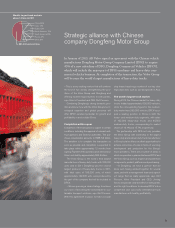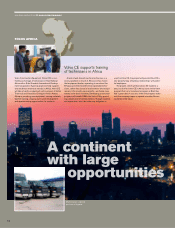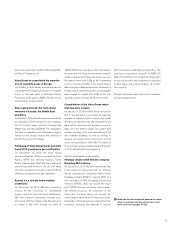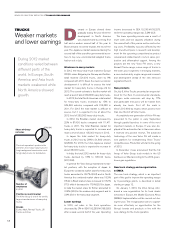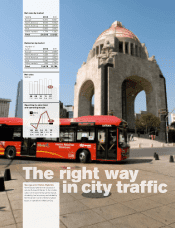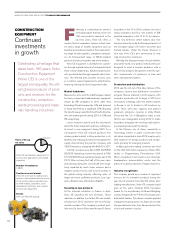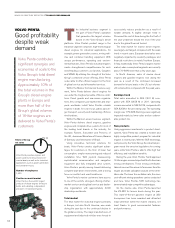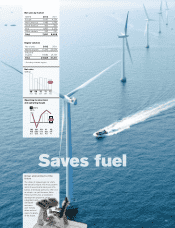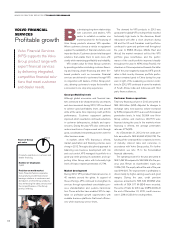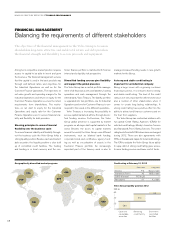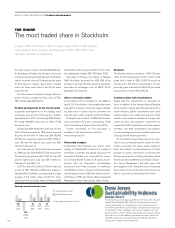Volvo 2012 Annual Report Download - page 64
Download and view the complete annual report
Please find page 64 of the 2012 Volvo annual report below. You can navigate through the pages in the report by either clicking on the pages listed below, or by using the keyword search tool below to find specific information within the annual report.
BOARD OF DIRECTORS’ REPORT 2012 GROUP PERFORMANCE
BUSES
Weak market
development
and lower
volumes
olvo Buses is one of the world’s
leading manufacturers of buses
and bus chassis. The product pro-
gram comprises complete trans-
port solutions, city buses, intercity buses and
coaches, as well as services in financing, vehicle
service, vehicle diagnostics and traffic informa-
tion. Volvo Buses has sales in 85 countries and
one of the industry’s strongest service networks,
with more than 1,500 dealerships and workshops
worldwide. Production facilities are found in
Europe, North America, South America and Asia.
Lower fuel consumption and emissions
During 2012, Volvo Buses presented a number
of new products, including a program of city
buses, intercity buses and coaches for the com-
ing European emission requirements Euro 6.
The new buses generate significantly lower
emissions of nitrogen oxide and particles, while
improving both fuel economy and climate impact,
compared with current vehicles. Two of the three
new engines included in the program can be
driven on bio-diesel. Sales will commence during
the second half of 2013.
In India, the product program was increased
with three new models, including the Volvo 9100
coach, which will provide Volvo Buses with good
opportunities to expand in a new, key seg ment. At
the same time, the expansion of the company’s
industrial capacity in India was intensified.
Increased sales of hybrid buses
Volvo Buses is world-leading in hybrid buses
and has sold a total of nearly 1,000 vehicles to
customers in 20 countries. In 2012, hybrid
buses were sold to cities including Curitiba,
Hamburg and Gothenburg. The most recent
model, the Volvo 7900 Hybrid, has up to 39%
lower fuel consumption and climate impact than
corresponding diesel buses. During the year, a
Volvo 7900 Hybrid articulated bus was intro-
duced, which meant an important strengthening
of the hybrid program. From 2014, all low-floor
buses sold by Volvo Buses in Europe will be
hybrid buses. To satisfy the increasing global
demand, Volvo Buses has also started the manu-
facturing of hybrid bus chassis in Brazil. The first
30 Brazilian-manufactured hybrid buses were
put in service in Curitiba in September 2012.
In parallel, the business area continued to
develop the next generation of hybrid buses – so
called plug-in hybrids. The technology means
that the bus batteries can be charged directly
from the electricity mains and that the bus can
operate silently and exhaust-free longer distances
on electricity alone. Diesel consumption and cli-
mate impact emission can be reduced by up to
75%, compared with comparable diesel-driven
buses. Field tests using three plug-in hybrids
will commence in Gothenburg in spring 2013.
In China, Volvo Buses is a driving force in
electro-mobility, partly through the partnership
in the bus manufacturer Sunwin Bus, one of the
world’s largest manufacturers of fully electric
buses, partly through a newly started company
for hybrid and electrical drive lines, Shanghai
Green Bus Drive System. Sunwin Bus delivered
413 fully electric buses during the year, which
made the company the leader in China and a
world-leading supplier of fully electric buses
over 10 meters in 2012.
Positive reception for new telematic system
Volvo Buses’ new telematic system, which was
presented in 2011, has been positively received
in the market and is now being used in over 20
countries. Volvo Bus Telematics provides bus
operators with better control of the vehicle’s fuel
consumption and the opportunity to adapt main-
tenance to exact requirements. Measures that
can generate fuel savings of approximately 10%.
Volvo’s hybrid buses are now equipped with the
Volvo Bus Telematics hardware.
Fewer deliveries and lower order intake
With the exception of China and India, the global
bus market declined in 2012. Volvo Buses deliv-
ered 10,678 buses and bus chassis (12,786). At
the same time, Volvo Buses’ market share in
Europe rose to 13%, thanks to sales of hybrid
buses. Markets shares were also strengthened in
North America and South America. The total order
intake was also lower for 2012 than in the preced-
ing year. However, several important orders were
signed during the year, for example, 460 front-
engine buses were sold to Belo Horizonte, Brazil
– a strategic breakthrough in a new segment – and
475 Nova hybrid buses to Quebec, Canada.
Due to lower volumes and higher pressure on
prices, Volvo Buses will concentrate manufac-
turing of complete buses in Europe to the com-
pany’s production facilities in Wroclaw, Poland.
This means that manufacturing at Volvo Buses
in Säffle, Sweden, will discontinue mid-2013.
Sales and earnings fell
During 2012, net sales fell to SEK 20,295 M
(21,823). Operating income declined to SEK 51
M (1,114) and the operating margin decreased to
0.3% (5.1) due to low volumes, a negative market
mix and low capacity utilization.
Buses offers complete buses and
chassis within city buses, intercity
buses and coaches as well as services
within vehicle service, vehicle diagnos-
tics and traffic information.
Number of employees
7,500
Position on world market
The business area is one of the
world’s largest producers of buses.
Brands
Volvo, Prevost, Nova and Sunwin.
V
The global market for
buses declined in 2012.
Sales for Volvo Buses fell
and profitability declined.
Share of Group
net sales
7% (7)
60



